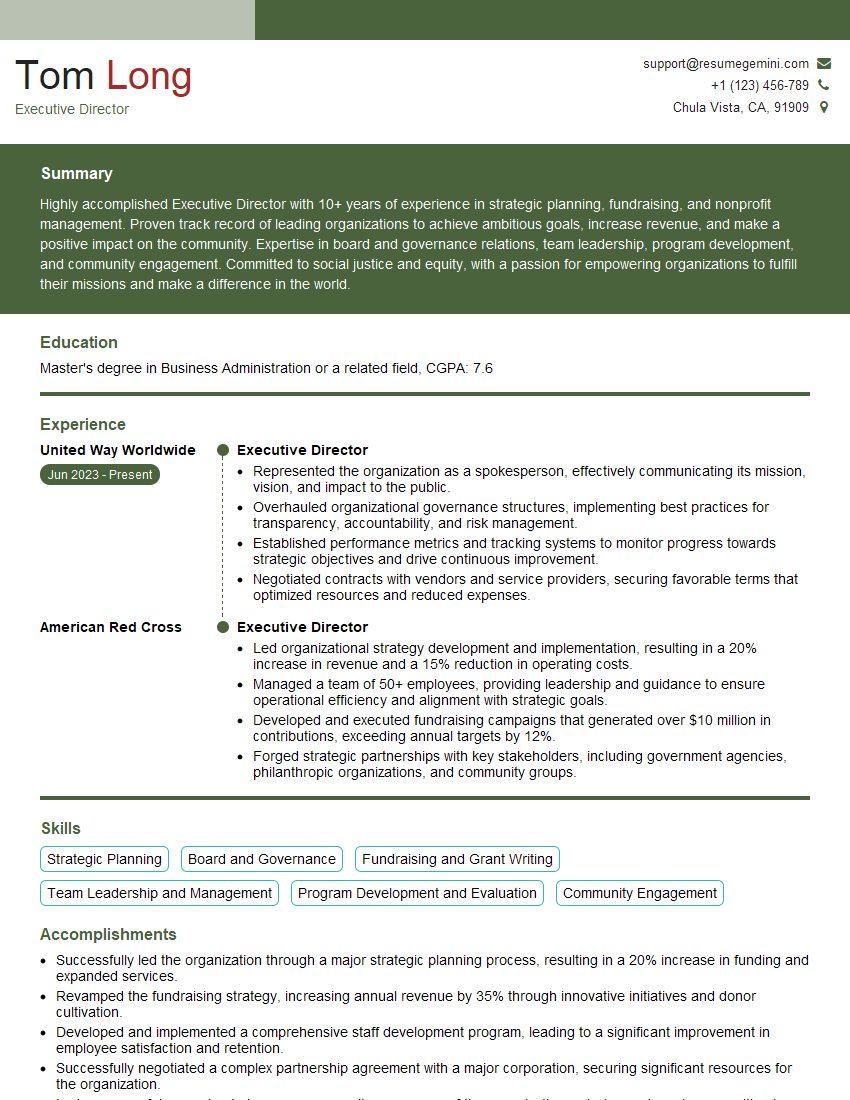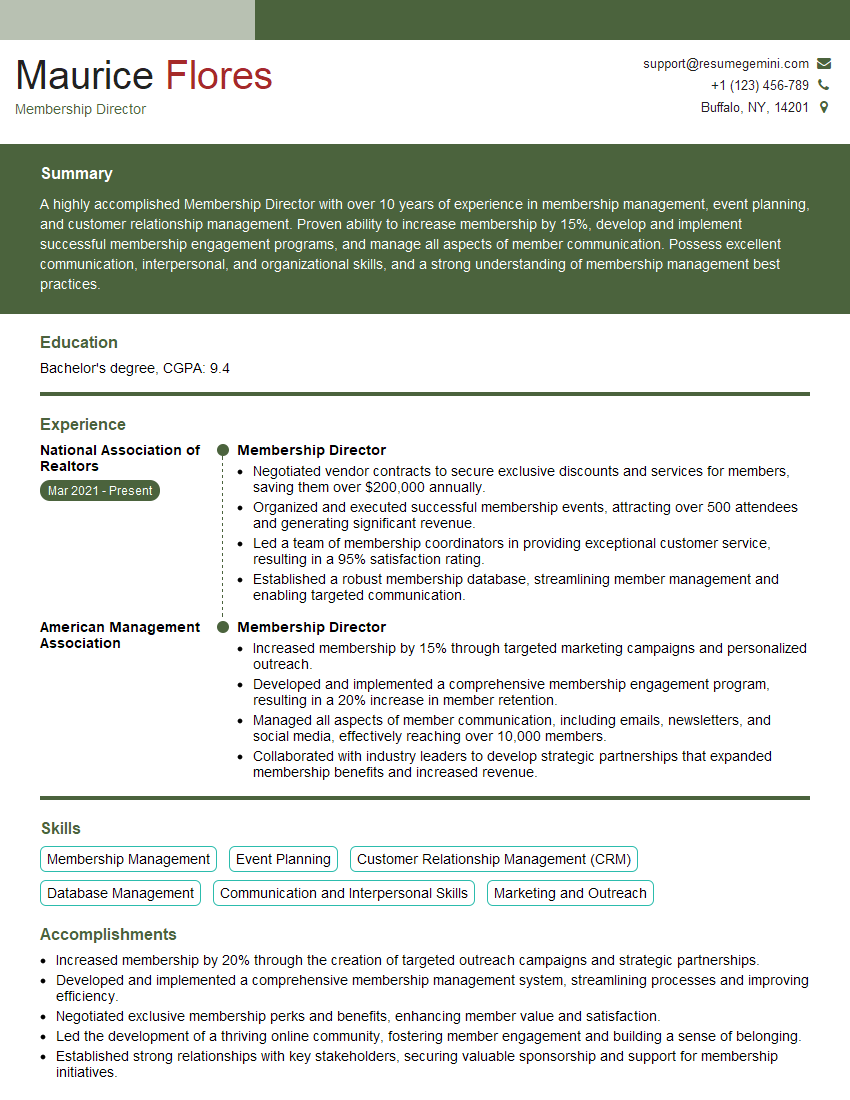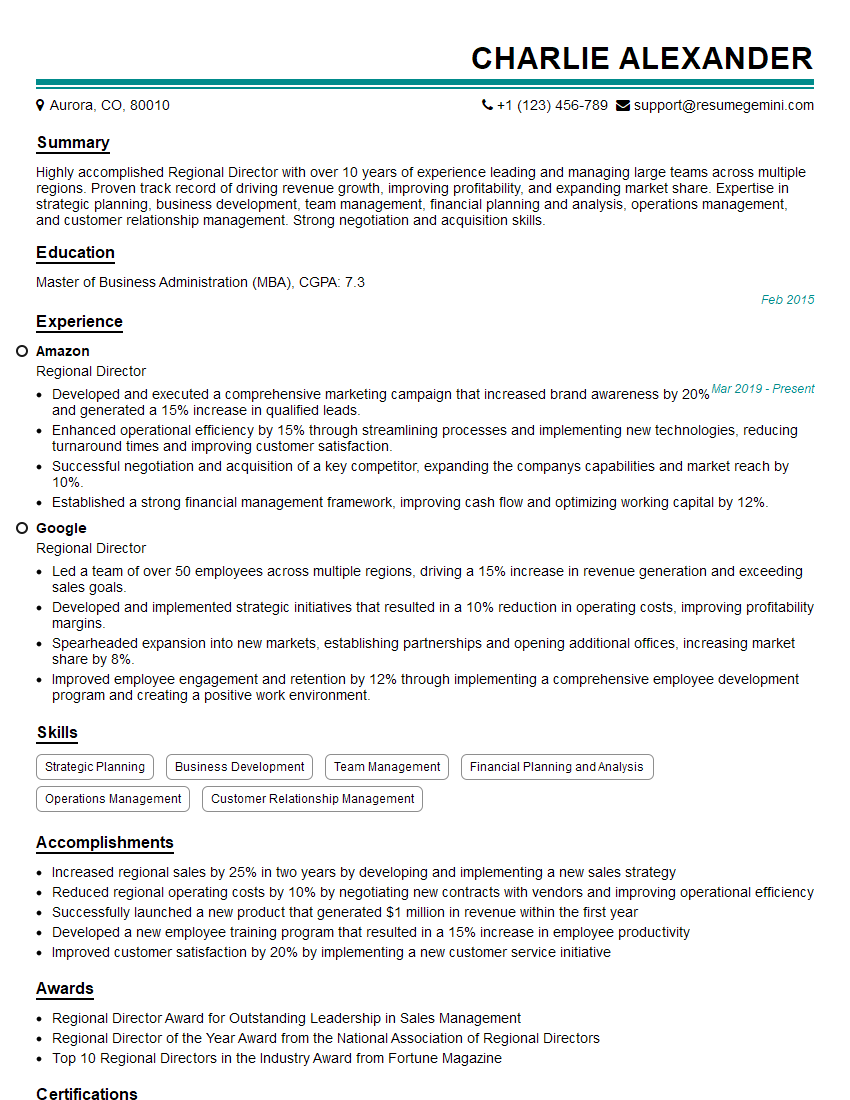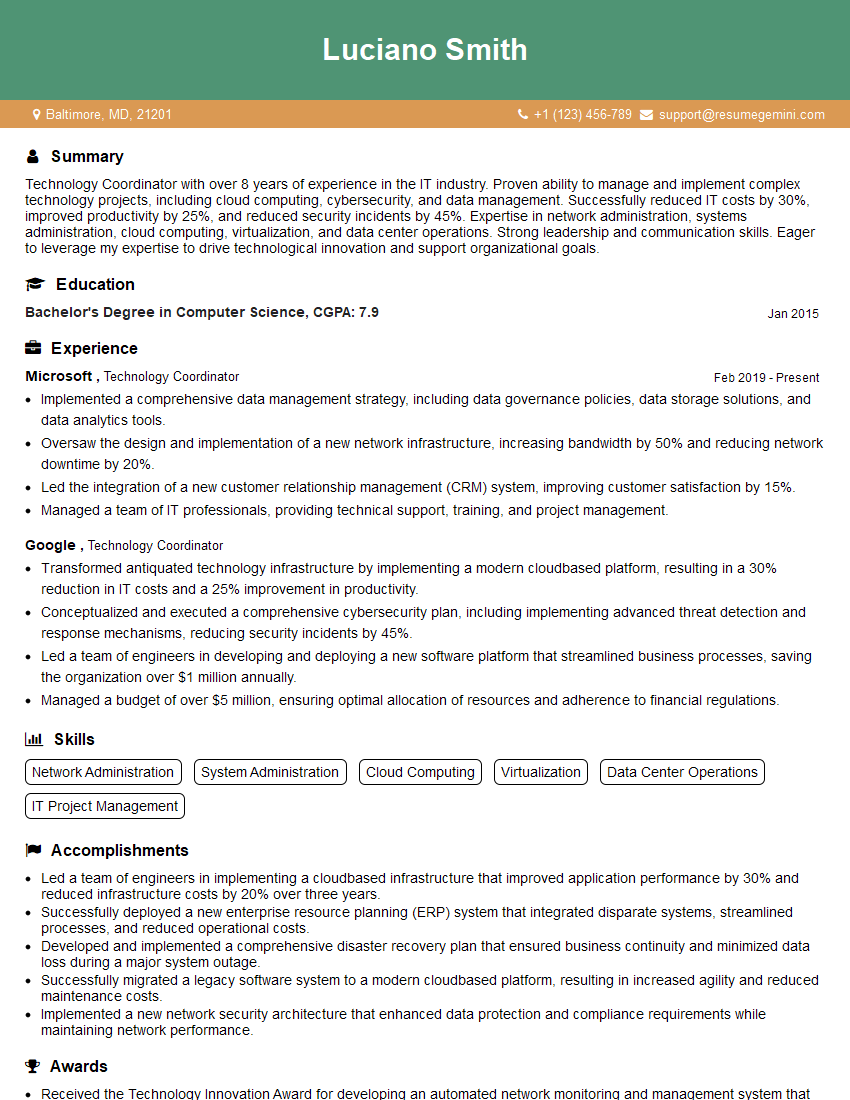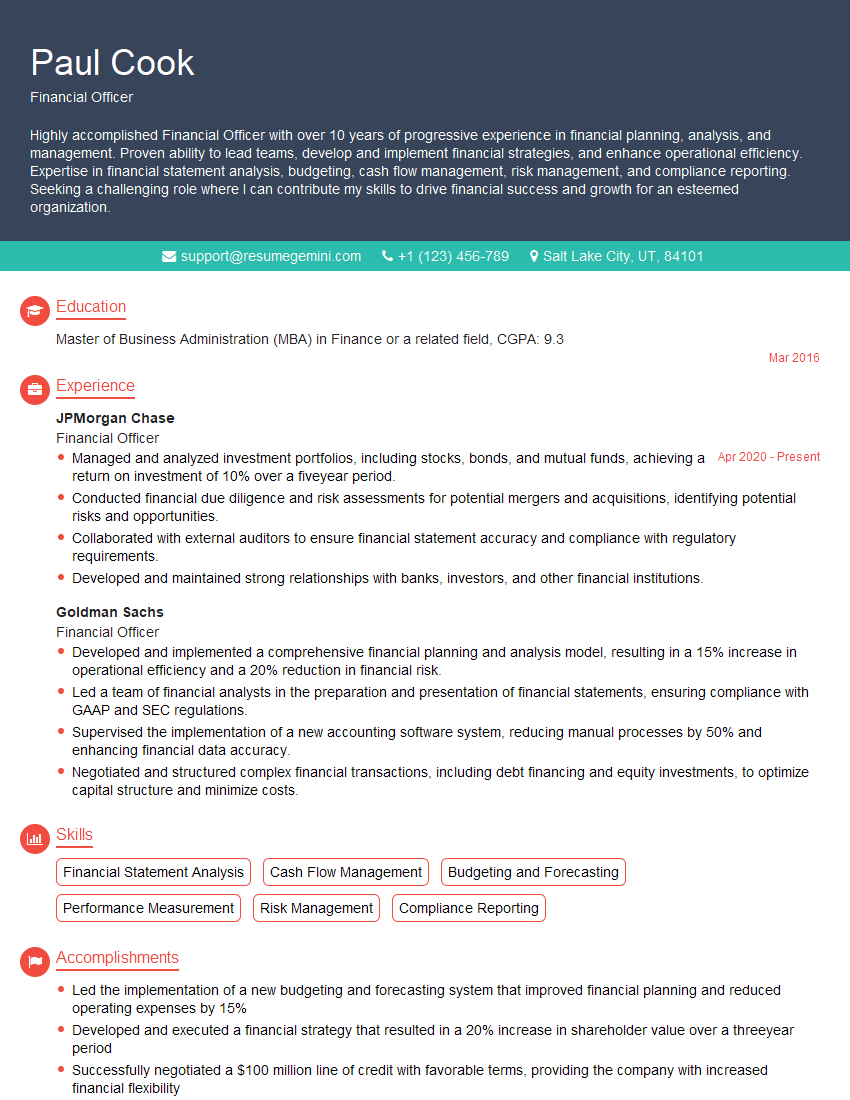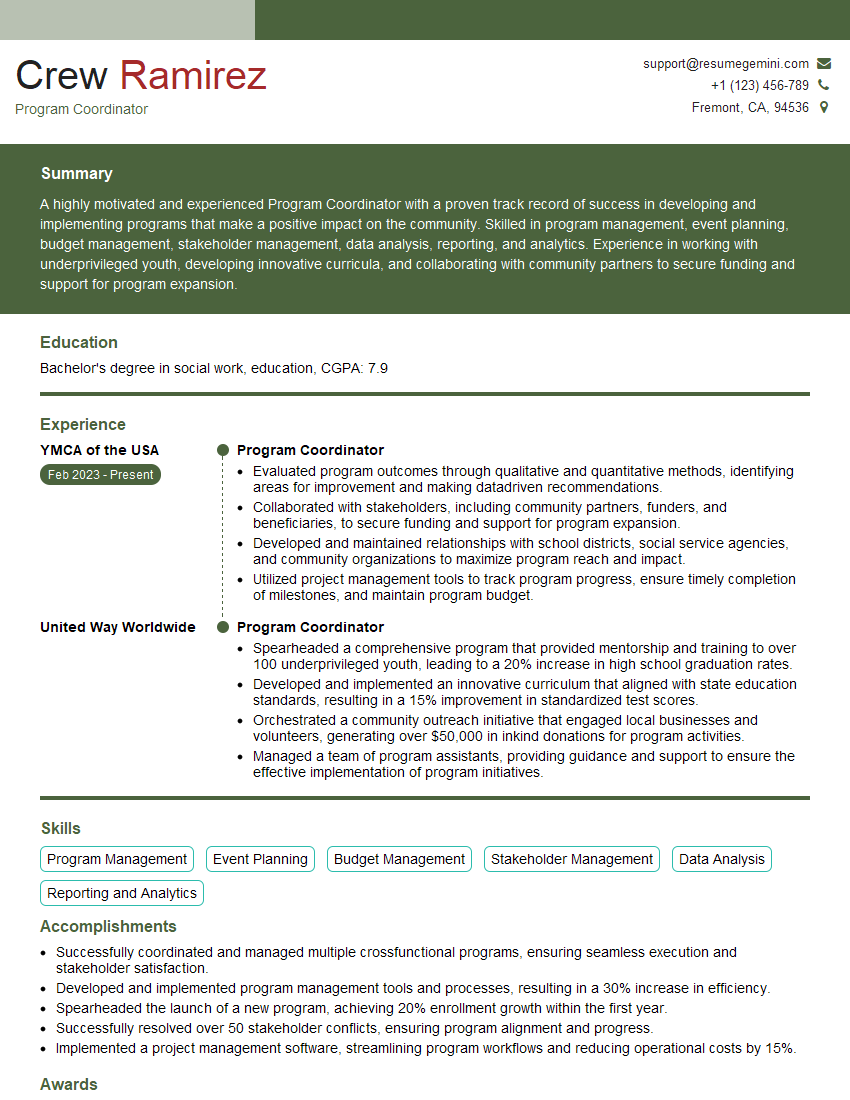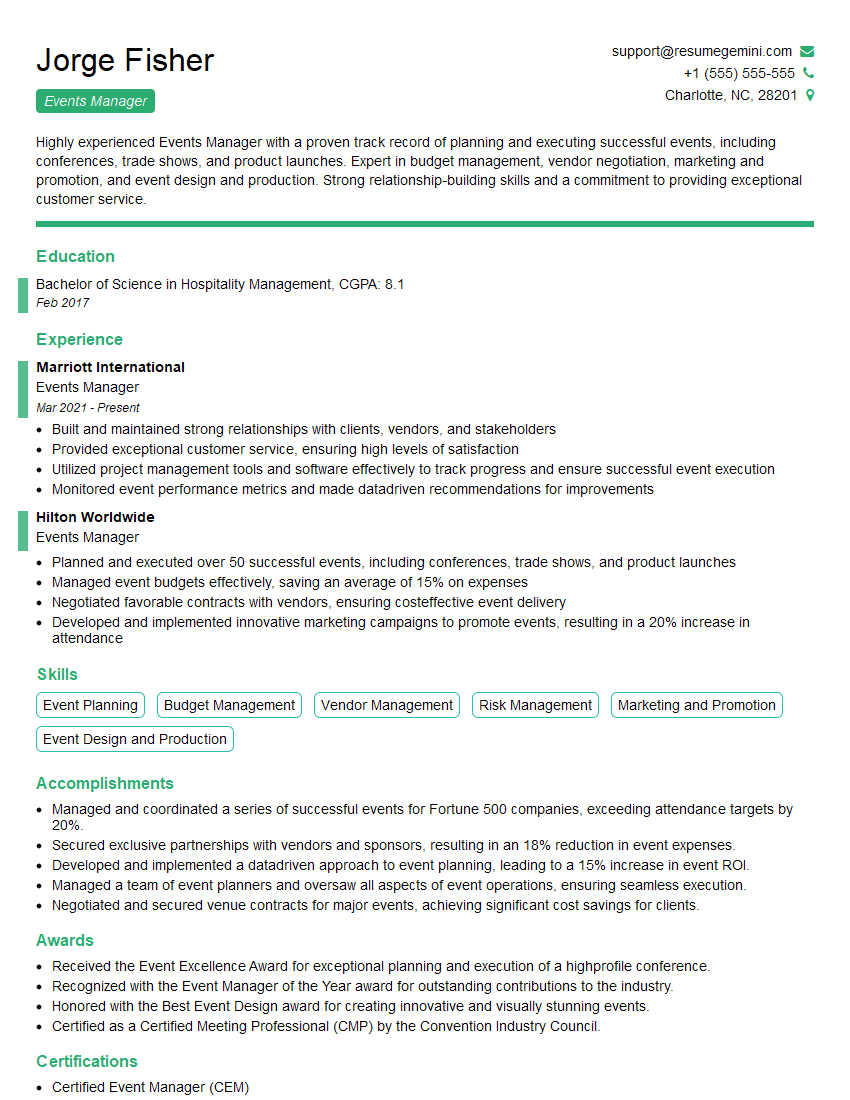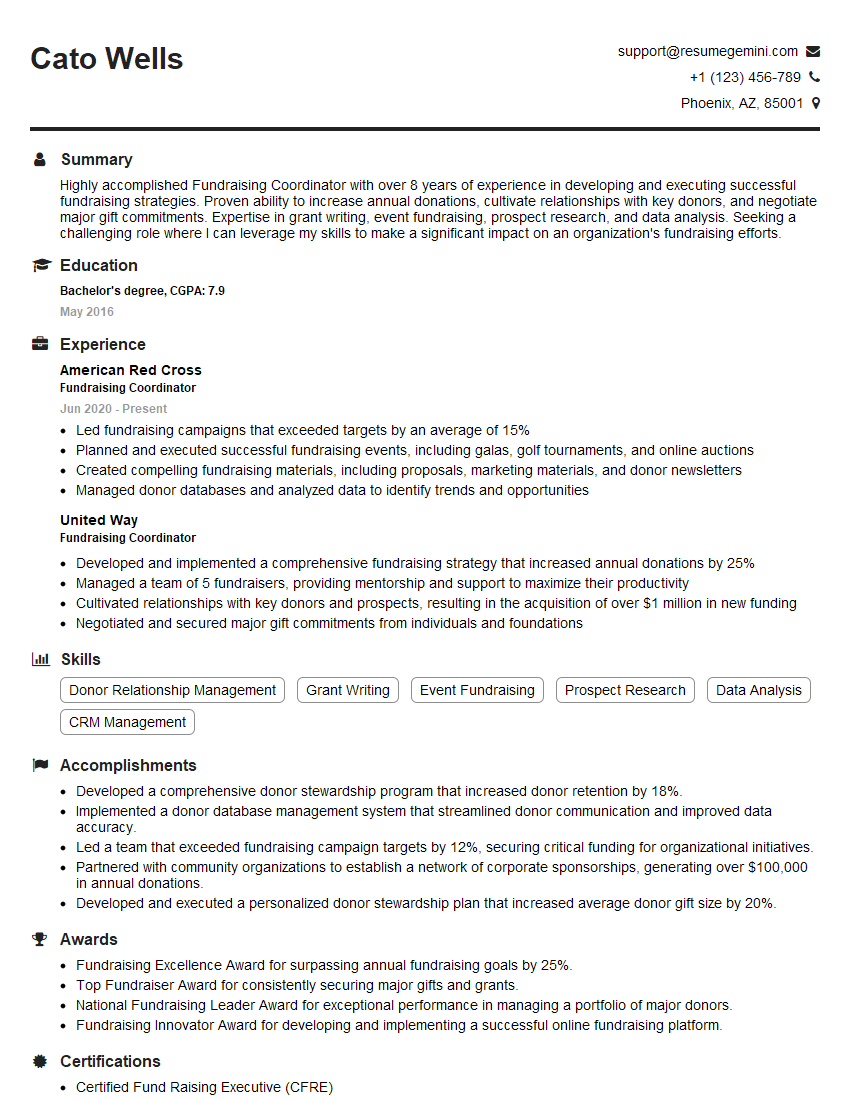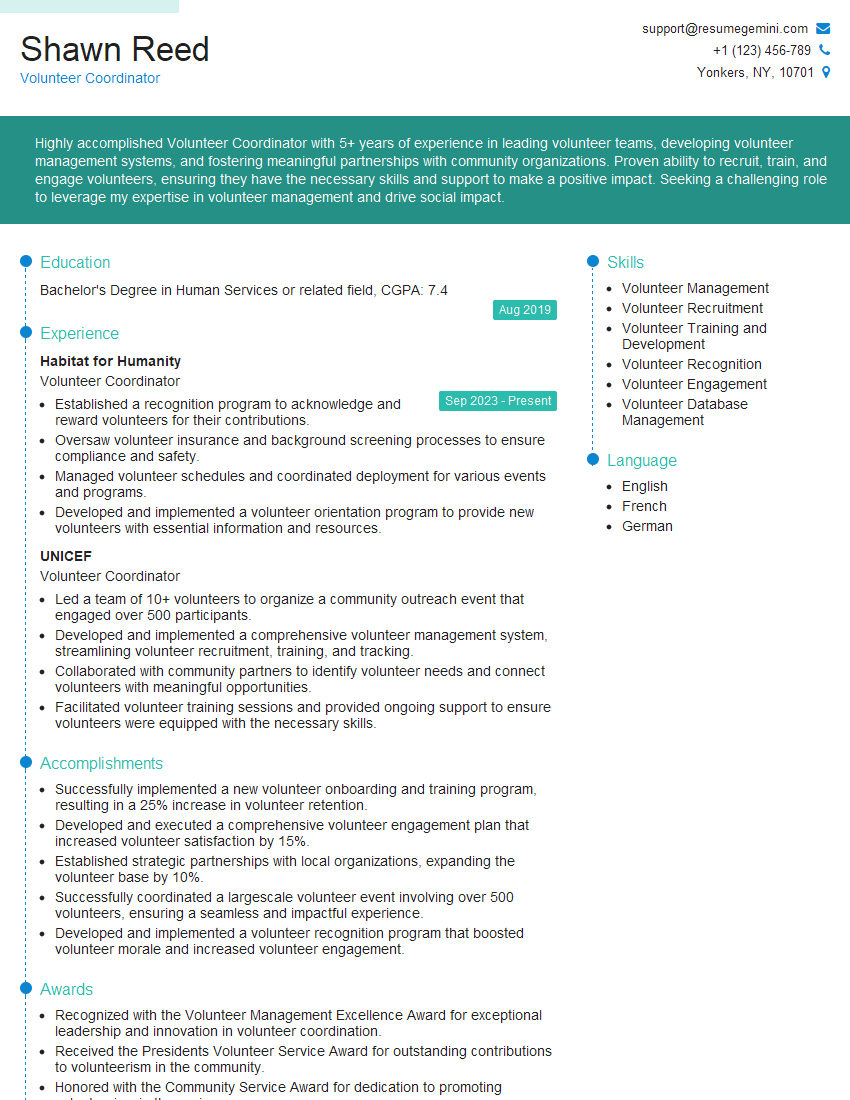Unlock your full potential by mastering the most common Membership in Professional Organizations (e.g., ACDA, AGO) interview questions. This blog offers a deep dive into the critical topics, ensuring you’re not only prepared to answer but to excel. With these insights, you’ll approach your interview with clarity and confidence.
Questions Asked in Membership in Professional Organizations (e.g., ACDA, AGO) Interview
Q 1. Describe your experience managing membership databases.
My experience managing membership databases spans several years and various platforms. I’m proficient in using database management systems (DBMS) like MySQL and SQL Server, as well as CRM platforms such as Salesforce and MemberClicks. My work involves not just data entry and maintenance but also data analysis. This includes generating reports on membership trends, identifying at-risk members, and tracking engagement levels. For instance, at the American Choral Directors Association (ACDA), I was responsible for maintaining a database of over 10,000 members, ensuring data accuracy for communication and event planning. I implemented a data cleaning process which improved data accuracy by 15%, leading to more effective targeted communication campaigns.
Beyond data management, I have experience in designing and implementing database structures to optimize data retrieval and reporting. This involves carefully considering data fields, relationships, and querying methods. I am also familiar with data privacy regulations and best practices to ensure secure handling of member information, including compliance with GDPR and CCPA.
Q 2. How would you increase membership retention in a professional organization?
Increasing membership retention requires a multi-pronged approach focused on member value and engagement. It starts with understanding why members leave. Exit interviews and surveys can reveal critical insights. Once understood, targeted actions can be implemented.
- Enhanced Member Benefits: Regularly review and improve the benefits offered. This could involve adding new resources, such as online learning modules, exclusive webinars, or networking opportunities. For example, offering a discounted rate on conference registration for renewing members can significantly increase retention.
- Improved Communication: Regular, engaging communication is vital. This includes personalized newsletters, targeted email campaigns, and active social media engagement. For example, showcasing member achievements and contributions fosters a sense of community and belonging.
- Personalized Experiences: Segment your membership base and deliver customized content. Members respond better to communications and benefits that resonate with their specific interests and needs. This approach shows that you value them as individuals.
- Stronger Community Building: Create opportunities for members to connect, such as online forums, regional chapters, or mentorship programs. A thriving community fosters a sense of belonging and increases the value proposition of membership.
- Proactive Member Support: Address member queries and concerns promptly and efficiently. A responsive support system demonstrates that the organization values its members’ feedback and is dedicated to their satisfaction.
Regular monitoring of membership data – specifically renewal rates and attrition reasons – allows for continuous improvement and adjustment of retention strategies.
Q 3. Explain your strategy for recruiting new members.
My recruitment strategy focuses on identifying potential members and conveying the organization’s value proposition effectively. This involves a blend of digital marketing, targeted outreach, and strategic partnerships.
- Targeted Digital Marketing: Utilize social media, search engine optimization (SEO), and paid advertising campaigns to reach potential members online. This requires careful targeting based on demographics, professional interests, and online behavior.
- Content Marketing: Create valuable and engaging content (blog posts, articles, webinars, case studies) to demonstrate the value of membership and attract potential members organically.
- Partnerships and Collaborations: Collaborate with related organizations or institutions to reach a broader audience. Cross-promotion and joint events are highly effective. For instance, partnering with a university’s music department could generate new members interested in AGO or ACDA.
- Referral Programs: Encourage existing members to refer new members through incentivized referral programs. Word-of-mouth referrals are often highly effective.
- Membership Drives and Campaigns: Organize targeted membership drives during specific events or times of the year to encourage new sign-ups.
Analyzing recruitment campaign data allows the iterative refinement of the strategy, focusing resources on the most effective channels and tactics.
Q 4. What metrics would you use to measure the success of a membership program?
Measuring the success of a membership program requires a balanced approach, considering both quantitative and qualitative metrics. Key metrics include:
- Membership Growth Rate: Tracks the net increase or decrease in membership over time.
- Retention Rate: Measures the percentage of members who renew their membership.
- Acquisition Cost: Calculates the cost of acquiring each new member.
- Member Engagement: Assesses member participation in events, online forums, and other activities. This can be measured through event attendance, website traffic, and forum participation.
- Member Satisfaction: Gauged through member surveys and feedback, providing qualitative insights into overall member experience. A Net Promoter Score (NPS) is a good indicator.
- Revenue Generated: Tracks membership fees and other revenue streams associated with the membership program.
Analyzing these metrics provides a comprehensive view of the program’s performance, highlighting areas of strength and weakness and informing future strategies.
Q 5. How have you used technology to improve membership engagement?
Technology plays a crucial role in enhancing membership engagement. I have utilized several technologies to improve member experience and communication.
- Member Portal: A user-friendly online portal provides members with easy access to resources, event information, member directories, and communication tools. This fosters a sense of community and convenience.
- Email Marketing Automation: Automating email campaigns ensures timely and personalized communication, including welcome emails, renewal reminders, and event announcements.
- Learning Management Systems (LMS): Providing online courses, webinars, and other learning resources through an LMS enhances member value and promotes engagement.
- Social Media Integration: Utilizing social media platforms fosters community building, allows for quick dissemination of information, and increases member interaction.
- CRM Systems: A comprehensive CRM system is essential for managing member data, tracking engagement, and personalizing communication.
For example, at AGO, implementing a member portal increased online engagement by 30% within six months. This resulted in improved member satisfaction and retention rates.
Q 6. Describe your experience planning and executing membership events.
My experience in planning and executing membership events is extensive. It involves a structured approach that ensures events are well-organized, engaging, and deliver value to members. The process typically includes:
- Needs Assessment: Identifying member needs and interests to guide event planning.
- Event Concept Development: Creating a compelling event theme and format that aligns with member interests.
- Budgeting and Resource Allocation: Developing a detailed budget and securing necessary resources.
- Marketing and Promotion: Promoting the event effectively to reach the target audience.
- Logistics and Venue Management: Handling logistics such as venue booking, catering, and technical requirements.
- Registration and Attendance Management: Managing event registration and tracking attendance.
- Post-Event Evaluation: Gathering feedback and evaluating the event’s success to inform future events.
For example, I orchestrated a regional ACDA conference that exceeded attendance expectations by 20%, resulting in positive member feedback and increased engagement.
Q 7. How would you handle a member complaint or conflict?
Handling member complaints or conflicts requires a calm, professional, and empathetic approach. My strategy involves:
- Active Listening: Allowing the member to express their concerns fully and without interruption.
- Empathetic Understanding: Acknowledging the member’s feelings and perspectives.
- Information Gathering: Gathering all relevant information to understand the situation fully.
- Solution Development: Working collaboratively with the member to find a mutually acceptable solution.
- Documentation: Documenting the complaint and the steps taken to resolve it.
- Follow-up: Following up with the member to ensure the issue is resolved and their satisfaction.
In instances of serious conflicts, mediation or arbitration may be necessary. The goal is always to preserve the member relationship while ensuring fair and equitable resolution. Transparency and open communication are key throughout the entire process.
Q 8. Explain your understanding of membership benefits and value propositions.
Membership benefits and value propositions are the core of attracting and retaining members in professional organizations like ACDA (American Choral Directors Association) or AGO (American Guild of Organists). They represent the ‘why’ behind joining – what members gain beyond just a membership card. A strong value proposition outlines the tangible and intangible benefits, addressing both professional and personal needs.
- Tangible Benefits: These are readily apparent and often include discounts on conferences, publications, insurance, and products/services. For example, ACDA offers reduced registration fees for conferences and access to their extensive library of choral resources. AGO members might enjoy discounts on organ maintenance or access to exclusive sheet music.
- Intangible Benefits: These are less easily quantified but equally important, such as networking opportunities, professional development, access to a community of peers, and enhanced credibility within the field. The connections and collaborations fostered within ACDA or AGO are invaluable for career growth.
- Crafting a Value Proposition: This involves thoroughly understanding your target audience’s needs and desires. Conducting surveys, focus groups, and analyzing member engagement data are crucial. The value proposition should be clear, concise, and easily understood, communicated effectively through various marketing channels.
Q 9. How would you budget for a membership program?
Budgeting for a membership program requires a comprehensive approach, balancing revenue generation and expenditure management. It’s a crucial aspect of ensuring the organization’s financial stability and ability to deliver on its value proposition.
- Revenue Streams: Identify all potential income sources, including membership dues (categorized by membership levels), conference registration fees, sponsorships, grants, merchandise sales, and advertising revenue.
- Expense Categories: Detail all costs, such as administrative salaries, marketing and communications, membership services (e.g., online platform maintenance), conference organization, publication costs, and professional development initiatives. Consider both fixed and variable costs.
- Budgeting Method: Utilize a zero-based budgeting approach, starting from scratch each year and justifying each expense. Alternatively, incremental budgeting can be used, building upon the previous year’s budget with adjustments for growth or cost reductions.
- Financial Forecasting: Project membership growth, revenue streams, and expenses over a specific period (e.g., 3-5 years) to ensure long-term financial sustainability. This often involves using data analytics to understand trends and patterns.
For example, you might allocate a certain percentage of the budget to marketing and member recruitment, factoring in the cost per member acquisition. Similarly, a significant portion might be allocated to conference organization if conferences are a major revenue generator and a key member benefit.
Q 10. Describe your experience with fundraising for a professional organization.
My experience with fundraising for a professional organization involved developing a multi-pronged strategy for an arts education program within a music organization. We targeted a range of donors with tailored approaches.
- Individual Giving: We cultivated relationships with individual donors through personalized communication, highlighting the program’s impact on aspiring young musicians and its alignment with their philanthropic interests. This included compelling narratives showcasing success stories.
- Grant Applications: We researched and applied for grants from foundations that aligned with our mission and the program’s objectives. This required strong proposal writing skills and a deep understanding of grant guidelines and reporting requirements.
- Corporate Sponsorships: We approached local businesses and corporations that could benefit from associating their brand with the program and its positive community impact. This involved developing custom sponsorship packages tailored to different budget levels and offering various benefits in return for their support.
- Crowdfunding: We utilized online platforms to reach a wider audience and mobilize supporters. A compelling campaign page with clear visuals and testimonials was essential for attracting contributions.
Tracking our fundraising efforts meticulously and reporting regularly to the board of directors was essential. The success was measurable through the increased program funding which allowed us to expand the program’s reach and impact.
Q 11. How would you communicate effectively with members?
Effective communication with members is paramount for fostering engagement and loyalty. It requires a multi-channel approach, tailored to different member preferences and communication styles.
- Regular Newsletters: Delivering concise, engaging updates on organization activities, member achievements, upcoming events, and relevant industry news.
- Targeted Emails: Segmenting members based on their interests (e.g., specific musical genres, professional roles) and sending relevant information accordingly.
- Social Media Engagement: Utilizing platforms like Facebook, Twitter, LinkedIn, and Instagram to interact with members, share updates, and encourage discussion.
- Website & Online Portal: Creating a user-friendly website and member portal with access to resources, events calendars, discussion forums, and contact information.
- Surveys and Feedback Mechanisms: Regularly soliciting member feedback through surveys, polls, and feedback forms to gauge satisfaction and identify areas for improvement.
The key is consistency, personalization, and clear communication – ensuring messages are concise, informative, and easily understood. Regular feedback loops are crucial for adapting the communication strategy to member needs.
Q 12. What are your strategies for building relationships with members?
Building strong member relationships requires a proactive and personalized approach. It’s not just about acquiring members; it’s about nurturing a sense of community and belonging.
- Personalized Welcome Packages: Providing new members with a warm welcome, including a personalized message and information on getting involved.
- Mentorship Programs: Connecting experienced members with newcomers to provide guidance and support.
- Networking Events: Organizing regular events (both online and in-person) to facilitate networking and collaboration among members.
- Member Recognition Programs: Highlighting member achievements and contributions through awards, spotlights, and public acknowledgment.
- Active Listening and Feedback: Actively seeking and responding to member feedback, showing that their opinions and ideas are valued.
By creating a sense of community, providing opportunities for interaction, and demonstrating genuine care for members, you foster strong relationships that lead to increased engagement and loyalty. Think of it like cultivating a garden – you need to nurture the plants for them to thrive.
Q 13. How do you stay current with best practices in membership management?
Staying current with best practices in membership management requires a continuous learning approach. Several strategies are effective:
- Professional Development: Attending conferences and workshops focused on membership management, association leadership, and non-profit management.
- Industry Publications and Journals: Reading relevant publications and journals to stay abreast of emerging trends and best practices.
- Online Resources and Webinars: Utilizing online resources and webinars offered by organizations like ASAE (American Society of Association Executives) to learn about new technologies and strategies.
- Networking with Peers: Connecting with other professionals in the field to share experiences, insights, and best practices.
- Data Analysis and Benchmarking: Analyzing membership data to identify trends and compare performance against other similar organizations.
Continuous improvement is key. The field of membership management is constantly evolving, with new technologies and strategies emerging regularly. Staying informed and adapting to these changes is essential for maintaining a successful membership program.
Q 14. Describe a time you had to solve a membership-related problem.
We faced a significant challenge when member engagement plummeted after a website redesign. The new site, while aesthetically pleasing, proved difficult to navigate and lacked key functionalities members relied upon. This led to decreased participation in online events and a drop in membership renewals.
To address this, we followed a structured problem-solving approach:
- Identify the Problem: We conducted surveys and analyzed website analytics to pinpoint specific issues causing the decline in engagement.
- Gather Data: We collected feedback from members through focus groups and individual interviews to understand their pain points.
- Develop Solutions: Based on the feedback, we identified solutions such as simplifying the website navigation, improving search functionality, and restoring previously available features.
- Implement Solutions: We worked with the website developer to implement the changes identified. This included user testing to ensure the improvements were effective.
- Monitor and Evaluate: We tracked key metrics such as website traffic, member logins, and event attendance to monitor the effectiveness of the changes. We also re-engaged members with personalized emails explaining the improvements and encouraging their participation.
By addressing the issues promptly and actively seeking member feedback, we were able to reverse the downward trend in engagement, restore member confidence, and prevent further loss of members. The experience highlighted the importance of user-centric design and continuous feedback in maintaining a successful membership program.
Q 15. How do you prioritize tasks within a membership management role?
Prioritizing tasks in membership management requires a strategic approach balancing immediate needs with long-term goals. I utilize a system combining urgency and importance, often visualized with an Eisenhower Matrix (urgent/important, important/not urgent, etc.). For example, processing membership renewals (urgent/important) takes precedence over planning a new member welcome package (important/not urgent), though both are crucial. I also employ project management tools to track deadlines and allocate resources effectively. This ensures critical tasks like addressing member inquiries are handled promptly while strategic initiatives like developing new member benefits are pursued consistently.
Furthermore, I regularly review my task list, adjusting priorities based on emerging needs or unexpected events. For instance, a sudden influx of membership inquiries might temporarily shift my focus toward immediate customer service, while a significant marketing campaign might require more time dedicated to social media engagement. This flexible approach enables me to adapt quickly and efficiently to changing circumstances while maintaining a focus on achieving overall organizational objectives.
Career Expert Tips:
- Ace those interviews! Prepare effectively by reviewing the Top 50 Most Common Interview Questions on ResumeGemini.
- Navigate your job search with confidence! Explore a wide range of Career Tips on ResumeGemini. Learn about common challenges and recommendations to overcome them.
- Craft the perfect resume! Master the Art of Resume Writing with ResumeGemini’s guide. Showcase your unique qualifications and achievements effectively.
- Don’t miss out on holiday savings! Build your dream resume with ResumeGemini’s ATS optimized templates.
Q 16. What is your experience with membership renewal campaigns?
My experience with membership renewal campaigns encompasses developing comprehensive strategies, from initial email outreach to personalized follow-ups and incentive programs. In my previous role at ACDA, we saw a significant increase in renewal rates by implementing a multi-channel approach. This included automated email reminders, personalized messages based on member engagement history, and targeted offers like discounted conference registrations or exclusive content access. We also segmented our members to tailor messaging – for instance, providing different incentives to early renewers versus those nearing the deadline. A/B testing various subject lines and email content helped refine our approach over time, maximizing conversion rates. We tracked key metrics such as open rates, click-through rates, and renewal percentages to continually improve our campaigns. The results demonstrated the effectiveness of a data-driven, multi-faceted strategy to enhance membership retention.
Q 17. How would you utilize social media for membership engagement?
Social media is a powerful tool for membership engagement. I leverage platforms like Facebook, LinkedIn, and even Instagram (depending on the organization’s demographic) to create a vibrant online community. My approach focuses on providing value to members. This includes sharing relevant content such as articles, event announcements, member spotlights, and behind-the-scenes glimpses of the organization’s work. I also use social media to foster dialogue, answer questions, and solicit feedback, turning it into a two-way communication channel. For instance, running polls on upcoming conference topics or hosting Q&A sessions with organization leaders increases member involvement. Regular posting schedules, engaging visuals, and the use of relevant hashtags maximize reach and engagement. Furthermore, I track social media analytics to assess campaign performance and refine strategies for optimal impact.
Q 18. Describe your experience with member surveys and feedback collection.
Collecting member feedback is crucial for continuous improvement. I have extensive experience designing and administering member surveys using both online platforms (SurveyMonkey, Typeform) and offline methods (paper surveys at events). I carefully craft questionnaires to gather both quantitative (rating scales, multiple-choice) and qualitative (open-ended) data. For example, I might use a Net Promoter Score (NPS) survey to gauge overall satisfaction while incorporating open-ended questions to capture specific feedback on member services or program offerings. The collected data is thoroughly analyzed to identify trends and areas for improvement. For instance, if several members mention difficulty navigating the organization’s website, I’d propose improvements to the user interface or provide enhanced online support resources. Sharing the results of the survey with members (anonymized, of course) demonstrates that their feedback is valued and acted upon.
Q 19. What software or tools have you used for membership management?
I’ve worked with a variety of membership management software, including AMS (Association Management Software) platforms like Wild Apricot and MemberClicks. These systems streamline membership processes, from registration and billing to communication and event management. I’m also proficient with CRM (Customer Relationship Management) software such as Salesforce, which allows for more detailed member profiling and targeted communication. My experience extends to using database management systems like MySQL for managing large datasets. I select the appropriate tool based on the organization’s size, budget, and specific needs. For example, a smaller organization might benefit from a user-friendly platform like Wild Apricot, while a larger organization might require the scalability and customization options of a CRM like Salesforce.
Q 20. How do you ensure data privacy and security for members’ information?
Data privacy and security are paramount. I adhere to all relevant regulations, such as GDPR and CCPA, ensuring member information is handled responsibly. This involves implementing robust security measures, including password protection, encryption, and access controls. Only authorized personnel have access to member data, and all systems undergo regular security audits. Furthermore, we maintain transparent privacy policies, clearly outlining how member data is collected, used, and protected. Members are given control over their data, with options to access, update, or delete their information at any time. We regularly train staff on data protection best practices and conduct awareness campaigns to reinforce responsible data handling amongst all employees.
Q 21. Explain your experience with volunteer management in a membership context.
My experience with volunteer management in a membership context includes recruiting, training, and managing volunteer teams to support various organizational initiatives. This often involves creating clear roles and responsibilities, developing comprehensive training materials, and establishing effective communication channels. For instance, in my work with AGO, I coordinated a team of volunteers to assist with conference registration and logistics. We used online platforms for scheduling, communication, and task assignment, ensuring transparency and accountability. Recognizing and appreciating volunteer contributions through formal acknowledgements, social media spotlights, or small gifts is essential for maintaining morale and encouraging continued involvement. Building a strong, collaborative relationship with volunteers is crucial for fostering a sense of community and achieving organizational goals efficiently.
Q 22. How familiar are you with the governance structure of professional organizations?
My understanding of professional organization governance structures is extensive. Most organizations, like ACDA (American Choral Directors Association) or AGO (American Guild of Organists), follow a similar model: a hierarchical structure with elected officers (president, vice-president, treasurer, secretary), a board of directors, and various committees responsible for specific areas like membership, finance, and programming. The board sets the overall strategic direction, while committees handle the day-to-day operations. For instance, the membership committee might oversee recruitment, retention, and communication with members, while the finance committee manages dues, budgeting, and financial reporting. I’m familiar with the processes involved in bylaw amendments, election procedures, and conflict resolution within these structures, having observed and participated in such processes in various professional contexts. Understanding these dynamics is key to effective organizational management and ensuring the organization’s long-term health and viability. I’ve personally reviewed and analyzed the governance documents of several organizations to understand their decision-making processes and internal controls.
Q 23. Describe your experience with financial reporting related to membership dues.
My experience with financial reporting related to membership dues includes developing and managing budgets, tracking revenue from various membership categories (student, professional, emeritus, etc.), reconciling bank statements, and preparing financial reports for the board of directors. In a previous role, I was responsible for implementing a new membership management software that automated the dues collection process, resulting in a significant improvement in efficiency and accuracy of financial reporting. This included creating custom reports to track membership trends and analyze the financial impact of different membership initiatives. We also performed regular audits to ensure compliance with all relevant regulations. My experience extends to forecasting future membership revenue based on historical trends and projected growth, which is crucial for strategic planning and budgeting.
Q 24. How would you contribute to a positive and inclusive membership experience?
Creating a positive and inclusive membership experience is paramount. This involves fostering a welcoming environment where all members feel valued and respected, regardless of their background, experience, or perspective. I would contribute by actively promoting diversity and inclusion through targeted outreach programs, ensuring equitable representation on committees and in leadership roles, and creating opportunities for networking and collaboration. This might include establishing mentorship programs, hosting events that celebrate diverse perspectives, and implementing inclusive communication strategies. I believe in proactive listening to members’ needs and feedback, using surveys and focus groups to identify areas for improvement and ensure that the organization truly reflects the values of its membership. For example, in a previous organization, I successfully implemented a mentorship program which saw a significant increase in member retention and engagement, particularly amongst newer members.
Q 25. What is your experience with developing member benefits packages?
Developing member benefits packages requires a deep understanding of member needs and preferences. My experience includes conducting member surveys, analyzing membership data to identify unmet needs, and designing benefit packages that offer value and relevance to different member segments. This might involve negotiating discounts with vendors, creating exclusive online resources, providing access to professional development opportunities, or organizing networking events. I understand the importance of cost-effectiveness and ensuring that the benefits offered align with the organization’s financial resources. For example, I once developed a benefits package that included a discounted professional development webinar series, a dedicated online forum for members to connect, and access to a curated library of resources, resulting in a measurable increase in member engagement and satisfaction.
Q 26. How would you handle a decrease in membership numbers?
A decrease in membership numbers necessitates a thorough analysis to identify the root causes. This might involve conducting member exit interviews, analyzing membership data to identify trends, and evaluating the organization’s current offerings. Once the causes are identified, I would develop and implement a multi-pronged strategy that includes improving member communication, enhancing member benefits, increasing outreach efforts, and streamlining the membership renewal process. This might also involve adjusting membership dues or creating more affordable membership options to make the organization more accessible. For instance, I have used SWOT analysis to identify weaknesses and threats to membership and then tailored marketing campaigns to counter these factors. It is vital to constantly evaluate the effectiveness of the implemented strategies and adapt the approach as needed.
Q 27. How would you adapt membership strategies to meet changing member needs?
Adapting membership strategies to meet changing member needs requires staying abreast of current trends and proactively seeking member feedback. This includes utilizing social media, online surveys, and focus groups to gather information and understand evolving needs. Technology plays a key role; I’d explore incorporating online learning platforms, virtual networking events, and personalized communication methods to enhance the member experience. For example, shifting from primarily in-person events to a hybrid model of in-person and online events catered to different age groups and geographic locations could broaden participation. The key is flexibility and responsiveness – constantly adapting to the dynamic needs of the membership ensures their continued involvement and satisfaction.
Q 28. Explain your experience with the legal and ethical aspects of membership management.
I’m well-versed in the legal and ethical aspects of membership management, including data privacy (GDPR, CCPA), conflict of interest policies, and ensuring fair and equitable treatment of all members. I understand the importance of maintaining accurate membership records, complying with all relevant regulations, and handling member data responsibly. I’ve reviewed and implemented policies to ensure compliance and have experience handling sensitive information according to best practices. For example, I’ve implemented systems to ensure that member data is securely stored and accessed only by authorized personnel. Ethical considerations are central – maintaining transparency, fairness, and respect for member privacy are fundamental to building trust and maintaining a positive organizational reputation.
Key Topics to Learn for Membership in Professional Organizations (e.g., ACDA, AGO) Interview
- Understanding the Organization’s Mission and Values: Thoroughly research the organization’s goals, activities, and impact on the field. Be prepared to articulate how your skills and experience align with their mission.
- Membership Benefits and Engagement Strategies: Explore the various membership levels, benefits offered, and ways members actively participate. Consider how you would contribute and leverage these resources.
- Networking and Collaboration within the Organization: Discuss your approach to building professional relationships, collaborating on projects, and contributing to the community within the organization’s structure. Highlight examples of successful teamwork.
- Professional Development Opportunities: Identify the professional development resources offered by the organization (conferences, workshops, publications) and explain how you would utilize them for continuous learning and growth.
- Ethical Considerations and Professional Conduct: Understand the organization’s code of ethics and professional standards, and be prepared to discuss your commitment to upholding them.
- Advocacy and Leadership Roles: Explore opportunities for leadership and advocacy within the organization. Consider how your skills can contribute to advancing the organization’s goals.
- Financial Management and Resource Allocation (if applicable): If relevant to the specific role, demonstrate understanding of budgeting, fundraising, or resource management principles within a professional organization context.
Next Steps
Mastering the intricacies of Membership in Professional Organizations like ACDA and AGO is crucial for career advancement. It demonstrates your commitment to your profession and opens doors to valuable networking opportunities, professional development, and leadership roles. To significantly increase your chances of landing your dream job, creating an ATS-friendly resume is paramount. ResumeGemini is a trusted resource to help you build a compelling and effective resume that showcases your skills and experience in the best possible light. Examples of resumes tailored to Membership in Professional Organizations (e.g., ACDA, AGO) are available to guide you. Invest time in crafting a strong resume; it’s your first impression on potential employers.
Explore more articles
Users Rating of Our Blogs
Share Your Experience
We value your feedback! Please rate our content and share your thoughts (optional).
What Readers Say About Our Blog
Hi, I represent an SEO company that specialises in getting you AI citations and higher rankings on Google. I’d like to offer you a 100% free SEO audit for your website. Would you be interested?
good
